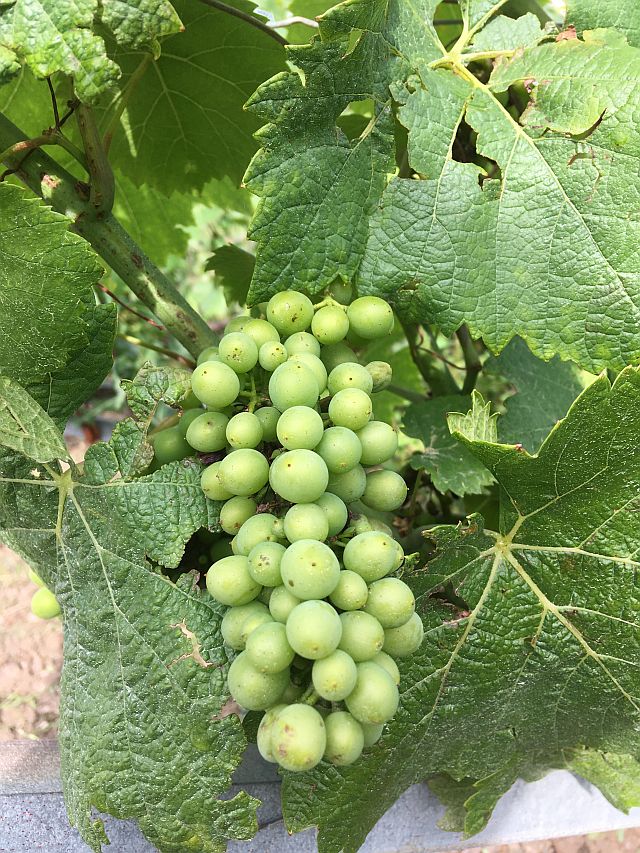Champagne Bulletin August 2021
2021 – could the weather get much worse?
Continuing poor weather in Champagne means that the start date for the harvest is being pushed further and further into the future with one champagne maker I spoke with this week saying that he doesn’t expect to start picking before about 20th September and I don’t suppose he is the only one thinking along the same lines.
In fact, as far as the vineyards are concerned, 2021 has been difficult from the very beginning and in terms of the proportion of the harvest lost to one problem or another, this year is being compared with some of the worst years in the past such as 2003 and 1990.
In past bulletins we mentioned the damage caused by the spring frosts; we’ve mentioned the fierce storms and hail that battered the vineyards in July when some regions of Champagne reported loses of 50%, or even more, of the potential harvest.
In more recent weeks it’s mildew that has been, and still is, the problem with the combination of a few spells of warm weather followed by huge amounts of rain creating the ideal humid conditions for an explosion of mildew.
To cap it all there are now some outbreaks of grey rot too.
All in all, the weather this year has been dreadful, and August has been no better.
All this means that the development of the grapes is a good 2 weeks behind the normal expectations and also that the health of the vines is extremely uneven across the many regions and sub-regions of Champagne.
There is significant variation even within each plot and from row to row as you can see from these two pictures. One picture shows good healthy bunches; the other shows grapes that are not in such good condition and the pictures were taken about 1 metre apart.
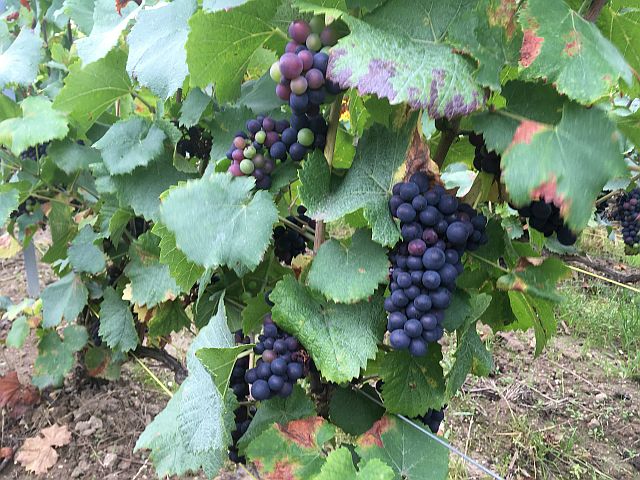
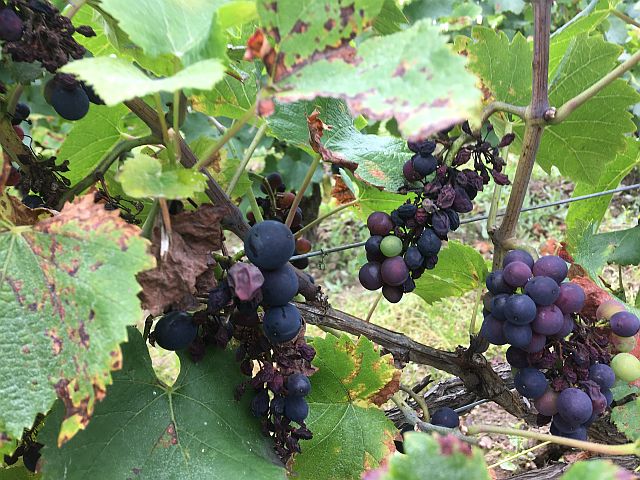
When the harvest does eventually get under way, pickers will have to be extremely careful to pick only the healthy grapes and even then, another careful sorting of the grapes will be essential in the winery before the remaining bunches are loaded into the presses.
Nevertheless, the usual monitoring system used every year in the run up to the harvest is in full swing. It’s called the Réseau Matu which means roughly the Maturity Network and it involves a team of vignerons from a selection of villages right across the region taking samples from the vineyards on a regular basis to analyse the development of the grapes in terms of sugar and acid levels as well as the number and weight of the bunches.
The data are then compared with the desired benchmarks and the results are used to determine the start date for the harvest which, ideally, is when all the indicators are judged to be as good as they are going to get each year.
As I write this, we are still two or even three weeks away from the start of the harvest and a lot can happen in that time, much of it depending on the weather.
Does this mean a shortage of champagne?
The short answer is ‘No’ and there are two good reasons for that.
First, you may have read reports in the press of impending champagne shortages and even stories of wealthy individuals reacting to those reports by sending their private jets over to France to bring back as many cases of champagne as they can carry.
However, despite what you might think, these shortages have little or nothing to do with conditions here in Champagne and more to do with problems associated with global trade.
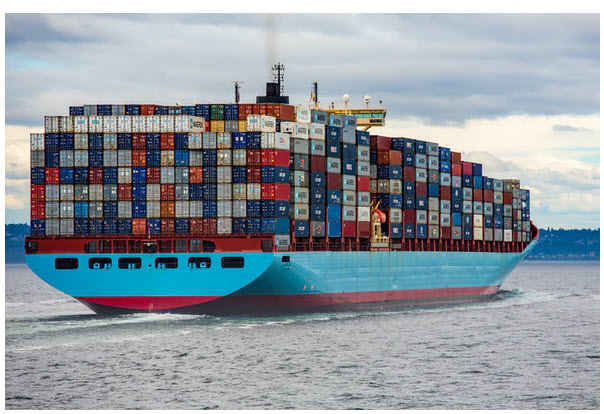 One of the issues facing all industries is that the pace and volume of global shipping has slowed down over the past year. Normally ships, and the containers they carry, are in almost constant transit around the globe – the containers are shipped to their destination, unloaded, loaded with a new cargo and the ships set off on the return voyage with the minimum of delay. In this way containers are always in use, in transit and available in the place where they are needed at the time when they are needed.
One of the issues facing all industries is that the pace and volume of global shipping has slowed down over the past year. Normally ships, and the containers they carry, are in almost constant transit around the globe – the containers are shipped to their destination, unloaded, loaded with a new cargo and the ships set off on the return voyage with the minimum of delay. In this way containers are always in use, in transit and available in the place where they are needed at the time when they are needed.
As business has slowed down over the past 18 months or so, it’s been taking longer to fill the containers for the return journey, so they are left empty waiting for the return cargo to materialise. This disrupts the entire system with the result that, back in the place of origin, goods that are ready to leave can’t be shipped because of the lack of available containers when they are needed.
In Champagne this has led to a shortage of incoming raw materials for dry goods that are needed for things such as foils, label, boxes etc and that has caused lead times for producing orders to lengthen considerably.
So rather than there being a shortage of champagne it would be more accurate to say that in some instances, the champagne is not where it is wanted at the time it is wanted.
This could be a concern as we enter the all-important end-of-year period for sales and consumption of champagne. Some commentators are suggesting that this will lead to a reduction in the number and scale of special discount offers on champagne. After all, if demand exceeds supply, even if only temporarily, why would you discount prices?
Reserve stocks
The second reason not to be alarmed about reports of possible shortages of champagne is that the Champagne region is well equipped to manage the fluctuations that are naturally associated with the annual harvest.
Champagne makers learned many, many years ago, that the harvests in Champagne are very variable and so they put in place a system of individual reserves by which each champagne maker is allowed to set aside a certain proportion of the wine from each year’ s harvest and store that against the possibility of a shortage of quantity or quality in subsequent years.
There are several ways of storing the ‘reserve wines’ as they are called. Some wine makers prefer to store each year’s wine separately in large wooden or stainless steel vats. They will also separate the wines by grape variety as well.

Other wine makers use what is called a ‘solera’ system or ‘perpetual reserve’ whereby one large vat contains wines from many previous years. Each year some wine is drawn off and the vat is topped up with wine from the current year. In this way the proportion of wines from earlier years slowly reduces, but nevertheless there is always a small percentage of very old wine left and this lends extra depth and complexity to the entire content of the vat.
These reserve wines not only ensure that the supply of champagne can be maintained at the level needed to meet demand, but they also explain why most champagne is called ‘non-vintage’. Since champagne is a blend of several wines from both the current year’s harvest and reserve wines from previous harvests, it’s not possible to say that it comes from one single harvest.
That’s why most champagne does not carry the date of one particular year and cannot therefore be called vintage champagne
A revolution in Champagne
You may remember reading in past bulletins about a vote that was due to take place in July about whether or not to adopt new viticultural methods that have the potential to change decades of accepted practice in this very traditional wine making region.
The issue at the heart of the debate is the need, or not, to adapt to changes in the climate whilst preserving the quality and distinctive style of the wine made here in Champagne.
Research into this question has been going on since 1995, so this is not something that has been rushed in to.
Well, the debate generated a lot of discussion, to say the very least, but the vote happened, and it went in favour of adopting the new methods of growing grapes.
What does this mean?
Not a lot in the short or even medium term.
This is a long-term project that affects the way the vines are planted in Champagne.
This new method of planting is called Vignes Semi-Larges or VSL for short and even a brief look at the details will give you an idea of what’s at stake.
The new proposal will allow, amongst other changes, the planting of vines in rows that are much farther apart than is currently permitted. Currently the maximum distance between rows is 1.5 metres, but the new rules will allow for up to 2.2 metres between rows. That may not sound like a big deal, but the implications are huge. (traditional style on the left – proposed style on the right)
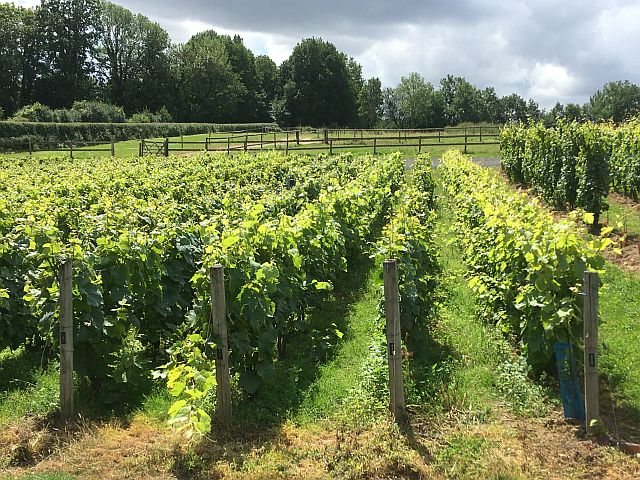
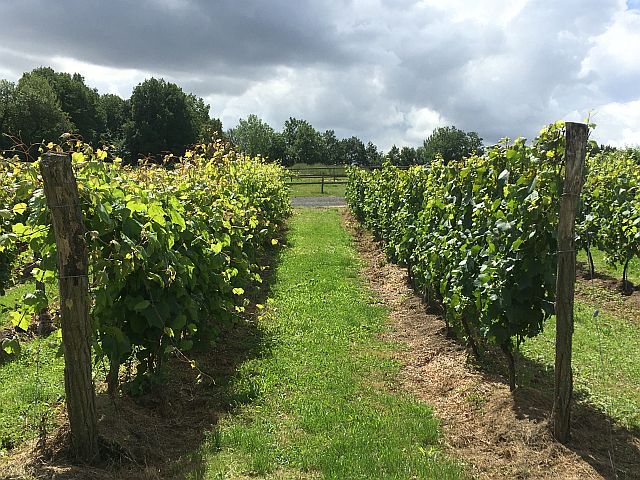
According to the research, the yield per hectare will be reduced by the new method, but the level of maturity of the grapes is expected to improve. Likewise, the level of acidity in the grapes, which is crucial for champagne, will increase.
The use of herbicides can be reduced or eliminated by the use of VSL.
The machinery currently used was developed specifically for rows a certain distance apart. New machinery may have to be purchased, possibly at great expense. On the other hand, the time and other costs associated with tending the vines should come down significantly.
Equally, it is expected that green house gas emissions will fall by 20% with the new system of planting in VSL.
The change to the rules it Is not mandatory. Each grower has the choice of which system of planting to use, traditional or VSL and it’s likely that the two systems will run in parallel for years, or even decades, to come. So, you’re not going to see a sudden and dramatic change on your next visit to Champagne, but over time the look of the countryside may well evolve so although this is indeed a revolution, it’s not going to happen overnight.
---
In next month’s bulletin the focus will be on the harvest:
When will it be?
How large will it be?
What will the quality be?
I’ll be back next month will some initial answers to these questions.
Until then…
All the best from Champagne
Jiles
When the harvest does eventually get under way, pickers will have to be extremely careful to pick only the healthy grapes and even then, another careful sorting of the grapes will be essential in the winery before the remaining bunches are loaded into the presses.
Nevertheless, the usual monitoring system used every year in the run up to the harvest is in full swing. It’s called the Réseau Matu which means roughly the Maturity Network and it involves a team of vignerons from a selection of villages right across the region taking samples from the vineyards on a regular basis to analyse the development of the grapes in terms of sugar and acid levels as well as the number and weight of the bunches.
The data are then compared with the desired benchmarks and the results are used to determine the start date for the harvest which, ideally, is when all the indicators are judged to be as good as they are going to get each year.
As I write this, we are still two or even three weeks away from the start of the harvest and a lot can happen in that time, much of it depending on the weather.
Does this mean a shortage of champagne?
The short answer is ‘No’ and there are two good reasons for that.
First, you may have read reports in the press of impending champagne shortages and even stories of wealthy individuals reacting to those reports by sending their private jets over to France to bring back as many cases of champagne as they can carry.
However, despite what you might think, these shortages have little or nothing to do with conditions here in Champagne and more to do with problems associated with global trade.
One of the issues facing all industries is that the pace and volume of global shipping has slowed down over the past year. Normally ships, and the containers they carry, are in almost constant transit around the globe – the containers are shipped to their destination, unloaded, loaded with a new cargo and the ships set off on the return voyage with the minimum of delay. In this way containers are always in use, in transit and available in the place where they are needed at the time when they are needed.
As business has slowed down over the past 18 months or so, it’s been taking longer to fill the containers for the return journey, so they are left empty waiting for the return cargo to materialise. This disrupts the entire system with the result that, back in the place of origin, goods that are ready to leave can’t be shipped because of the lack of available containers when they are needed.
In Champagne this has led to a shortage of incoming raw materials for dry goods that are needed for things such as foils, label, boxes etc and that has caused lead times for producing orders to lengthen considerably.
So rather than there being a shortage of champagne it would be more accurate to say that in some instances, the champagne is not where it is wanted at the time it is wanted.
This could be a concern as we enter the all-important end-of-year period for sales and consumption of champagne. Some commentators are suggesting that this will lead to a reduction in the number and scale of special discount offers on champagne. After all, if demand exceeds supply, even if only temporarily, why would you discount prices?
Reserve stocks
The second reason not to be alarmed about reports of possible shortages of champagne is that the Champagne region is well equipped to manage the fluctuations that are naturally associated with the annual harvest.
Champagne makers learned many, many years ago, that the harvests in Champagne are very variable and so they put in place a system of individual reserves by which each champagne maker is allowed to set aside a certain proportion of the wine from each year’ s harvest and store that against the possibility of a shortage of quantity or quality in subsequent years.
There are several ways of storing the ‘reserve wines’ as they are called. Some wine makers prefer to store each year’s wine separately in large wooden or stainless steel vats. They will also separate the wines by grape variety as well.
Other wine makers use what is called a ‘solera’ system or ‘perpetual reserve’ whereby one large vat contains wines from many previous years. Each year some wine is drawn off and the vat is topped up with wine from the current year. In this way the proportion of wines from earlier years slowly reduces, but nevertheless there is always a small percentage of very old wine left and this lends extra depth and complexity to the entire content of the vat.
These reserve wines not only ensure that the supply of champagne can be maintained at the level needed to meet demand, but they also explain why most champagne is called ‘non-vintage’. Since champagne is a blend of several wines from both the current year’s harvest and reserve wines from previous harvests, it’s not possible to say that it comes from one single harvest.
That’s why most champagne does not carry the date of one particular year and cannot therefore be called vintage champagne
A revolution in Champagne
You may remember reading in past bulletins about a vote that was due to take place in July about whether or not to adopt new viticultural methods that have the potential to change decades of accepted practice in this very traditional wine making region.
The issue at the heart of the debate is the need, or not, to adapt to changes in the climate whilst preserving the quality and distinctive style of the wine made here in Champagne.
Research into this question has been going on since 1995, so this is not something that has been rushed in to.
Well, the debate generated a lot of discussion, to say the very least, but the vote happened, and it went in favour of adopting the new methods of growing grapes.
What does this mean?
Not a lot in the short or even medium term.
This is a long-term project that affects the way the vines are planted in Champagne.
This new method of planting is called Vignes Semi-Larges or VSL for short and even a brief look at the details will give you an idea of what’s at stake.
The new proposal will allow, amongst other changes, the planting of vines in rows that are much farther apart than is currently permitted. Currently the maximum distance between rows is 1.5 metres, but the new rules will allow for up to 2.2 metres between rows. That may not sound like a big deal, but the implications are huge. (traditional style on the left – proposed style on the right)
According to the research, the yield per hectare will be reduced by the new method, but the level of maturity of the grapes is expected to improve. Likewise, the level of acidity in the grapes, which is crucial for champagne, will increase.
The use of herbicides can be reduced or eliminated by the use of VSL.
The machinery currently used was developed specifically for rows a certain distance apart. New machinery may have to be purchased, possibly at great expense. On the other hand, the time and other costs associated with tending the vines should come down significantly.
Equally, it is expected that green house gas emissions will fall by 20% with the new system of planting in VSL.
The change to the rules it Is not mandatory. Each grower has the choice of which system of planting to use, traditional or VSL and it’s likely that the two systems will run in parallel for years, or even decades, to come. So, you’re not going to see a sudden and dramatic change on your next visit to Champagne, but over time the look of the countryside may well evolve so although this is indeed a revolution, it’s not going to happen overnight.
---
In next month’s bulletin the focus will be on the harvest:
When will it be?
How large will it be?
What will the quality be?
I’ll be back next month will some initial answers to these questions.
Until then…
All the best from Champagne
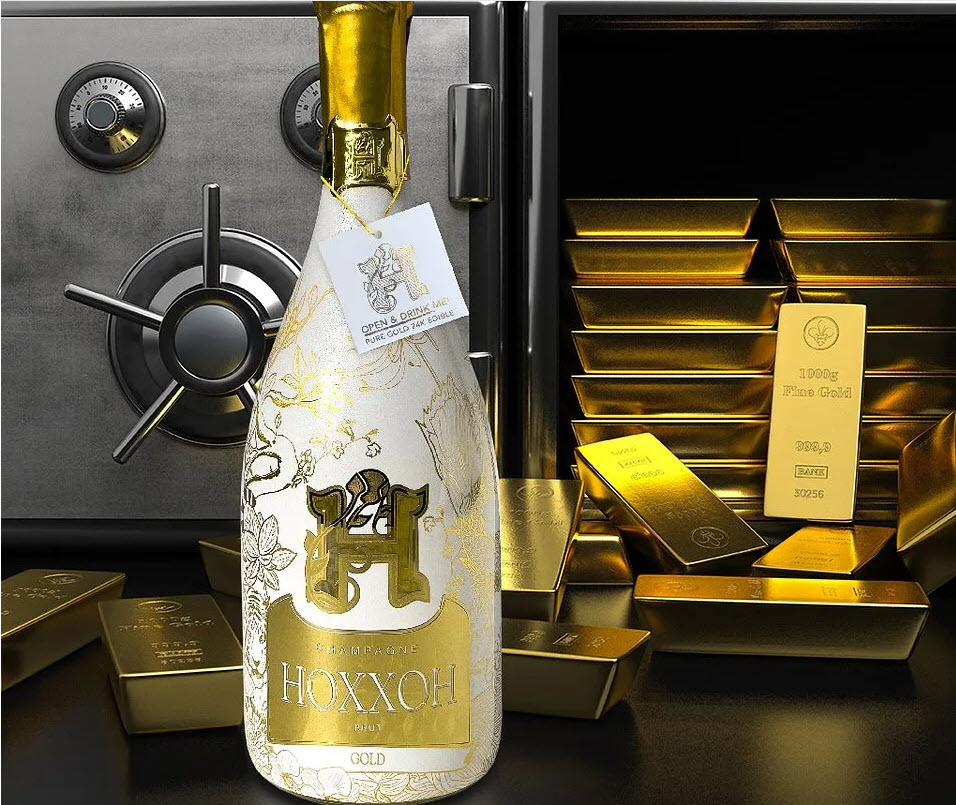 Meanwhile another new brand is attracting a number of articles and a lot of attention. It’s called Hoxxoh (no, don’t ask me how to pronounce that; I have no idea) and it is certainly eye-catching.
Meanwhile another new brand is attracting a number of articles and a lot of attention. It’s called Hoxxoh (no, don’t ask me how to pronounce that; I have no idea) and it is certainly eye-catching.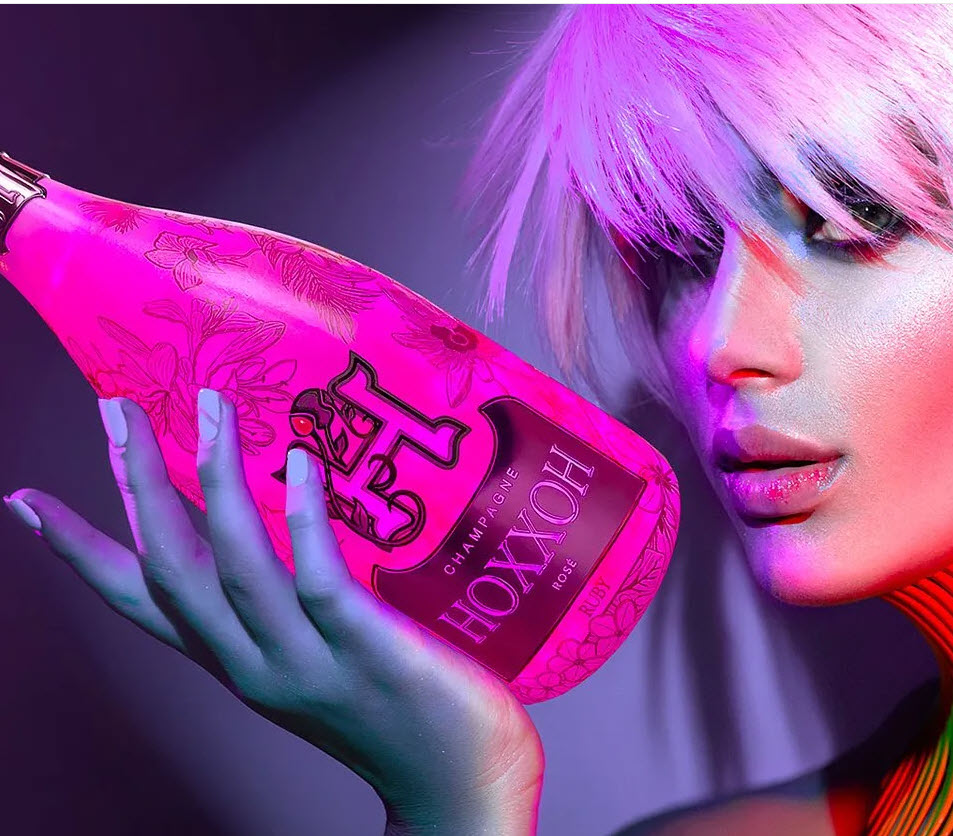 and a small 0.45 carat ruby is embedded in the label of each bottle of the rosé.
and a small 0.45 carat ruby is embedded in the label of each bottle of the rosé.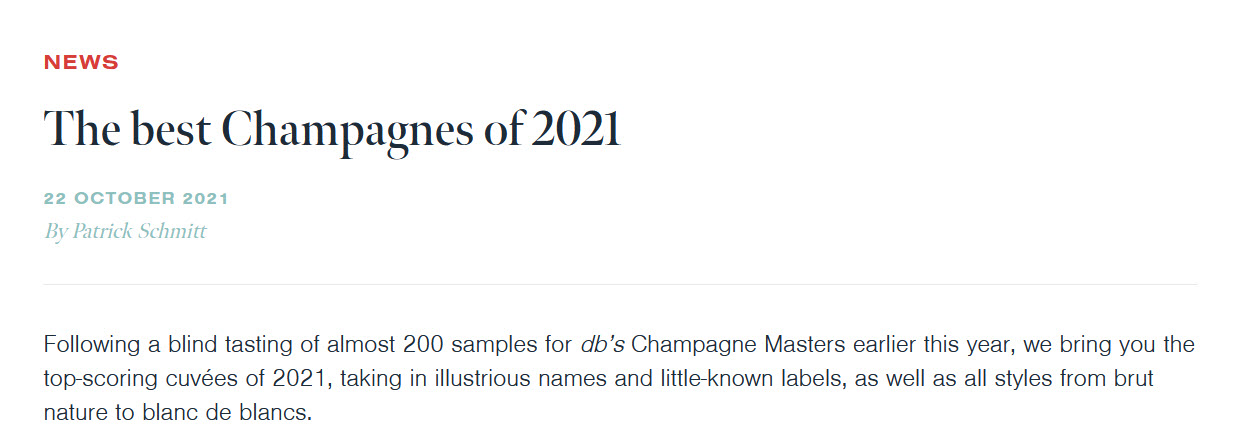 What is of interest is not so much the names of the brands but rather the information that is given about each of them, in particular the retail price. The prices are the those in the U.K. so they are not directly comparable to prices in other markets but the positioning relatively to one another is relevant, as are the price categories that emerge.
What is of interest is not so much the names of the brands but rather the information that is given about each of them, in particular the retail price. The prices are the those in the U.K. so they are not directly comparable to prices in other markets but the positioning relatively to one another is relevant, as are the price categories that emerge. The last ‘normal’ year for champagne sales was 2019 when annual shipments reached just 297 million bottles. That’s still a lot of bottles but it was a disappointing result for the champagne industry which had seen shipments decline steadily over the preceding 10 years from a total of 320 million bottles.
The last ‘normal’ year for champagne sales was 2019 when annual shipments reached just 297 million bottles. That’s still a lot of bottles but it was a disappointing result for the champagne industry which had seen shipments decline steadily over the preceding 10 years from a total of 320 million bottles.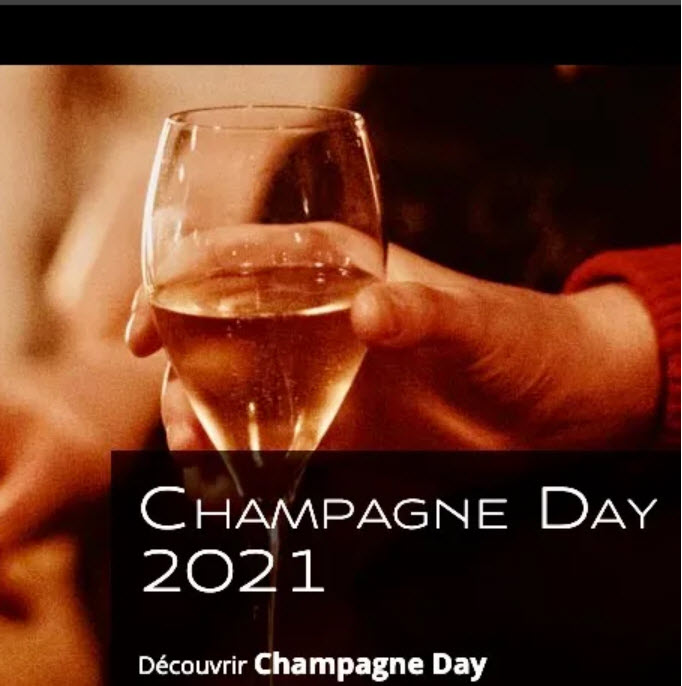 You may not have noticed it, but October 22nd was Global Champagne Day. In fact, this date has been GCD ever since the initiative was started about 10 years ago.
You may not have noticed it, but October 22nd was Global Champagne Day. In fact, this date has been GCD ever since the initiative was started about 10 years ago.

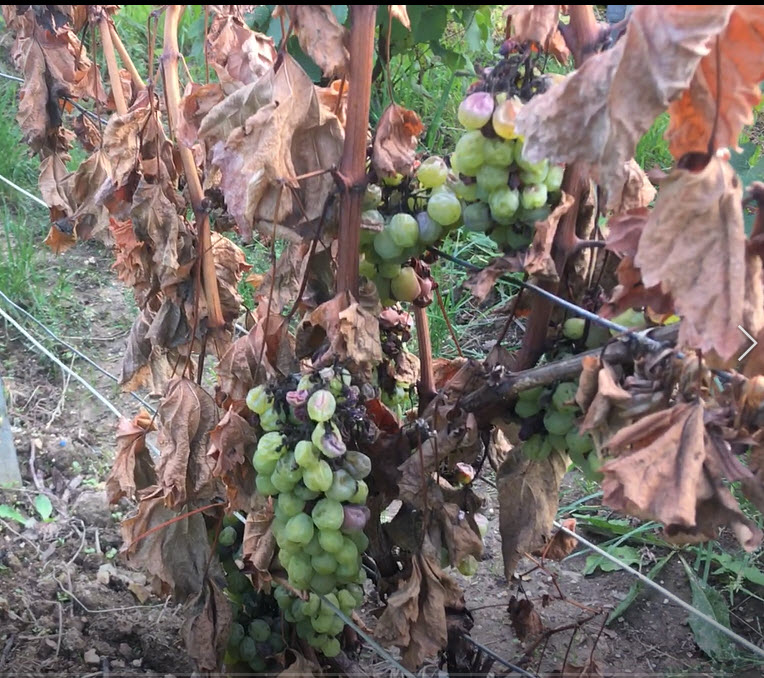

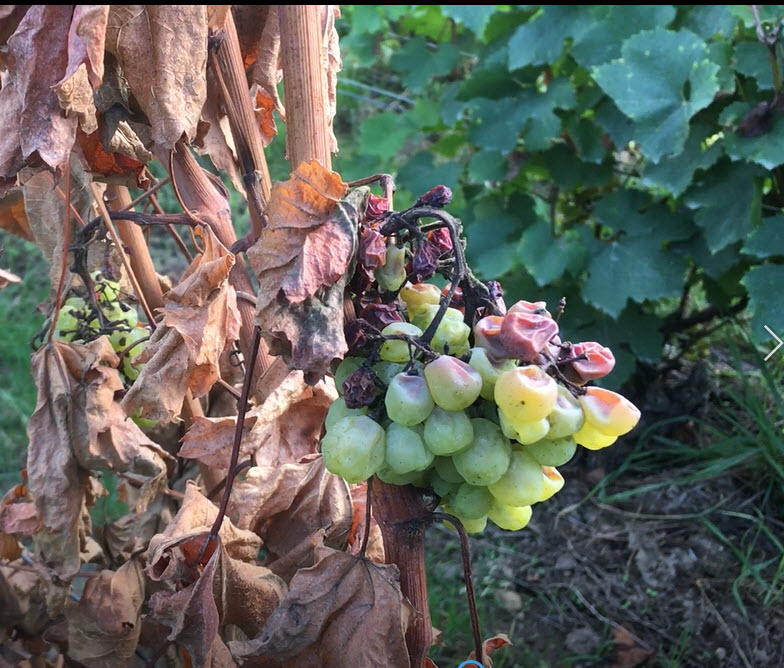
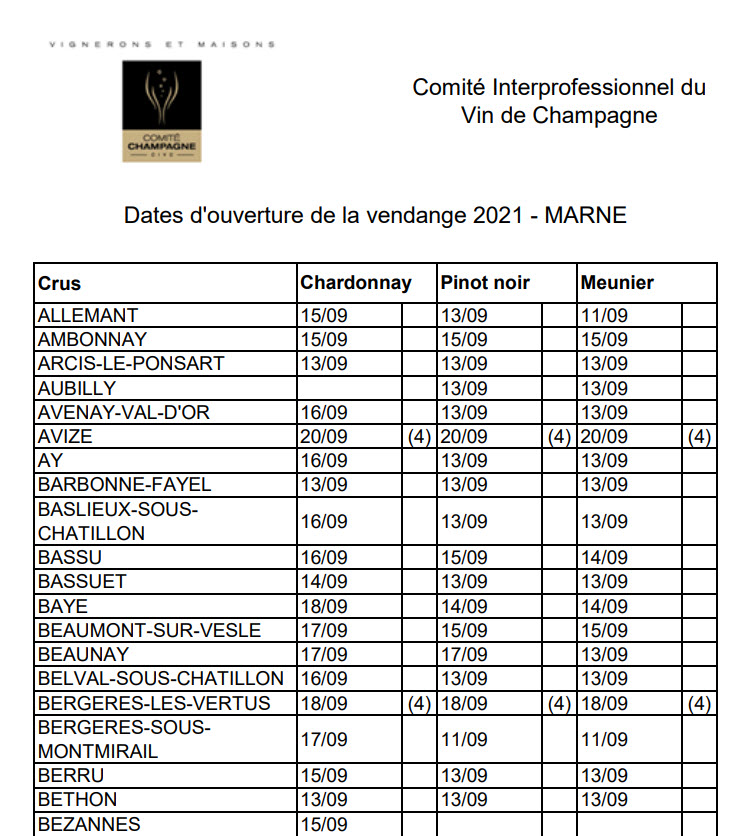 Picking doesn’t start on a specific date across the entire Champagne region. Instead, each village - and there are some 320 of these in Champagne - is given a start date based on the development of the grapes in each local area and there is also a start date given for each grape variety. You will immediately begin to appreciate that, despite the fact that many champagne drinkers think that all champagne is pretty much the same, that’s not really the case.
Picking doesn’t start on a specific date across the entire Champagne region. Instead, each village - and there are some 320 of these in Champagne - is given a start date based on the development of the grapes in each local area and there is also a start date given for each grape variety. You will immediately begin to appreciate that, despite the fact that many champagne drinkers think that all champagne is pretty much the same, that’s not really the case.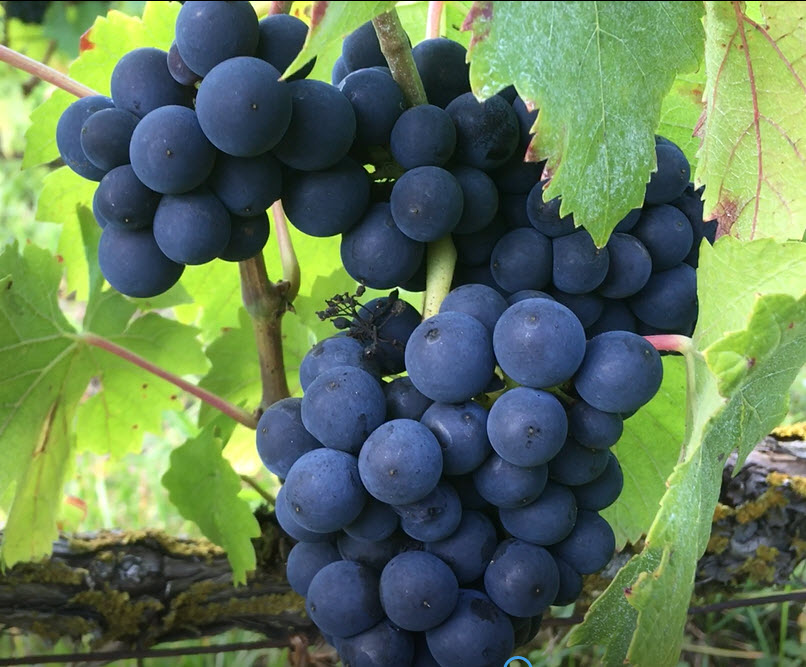 On the other hand, some villages nearer to Reims such as Ambonnay and Bouzy, both famed for their Pinot Noir grapes, were relatively untouched by the problems elsewhere and brought in a big harvest of grapes in excellent condition.
On the other hand, some villages nearer to Reims such as Ambonnay and Bouzy, both famed for their Pinot Noir grapes, were relatively untouched by the problems elsewhere and brought in a big harvest of grapes in excellent condition.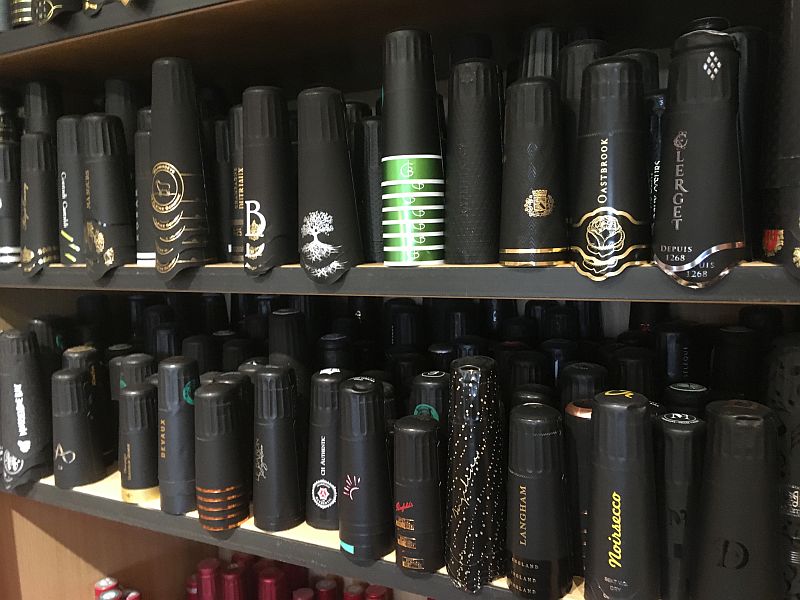 For example, supplies of aluminium for making foils are harder to come by and the same is true of paper to make labels and boxes. Lead times that would have been two months a year ago are now running to three, or even four months at the moment.
For example, supplies of aluminium for making foils are harder to come by and the same is true of paper to make labels and boxes. Lead times that would have been two months a year ago are now running to three, or even four months at the moment.

 One of the issues facing all industries is that the pace and volume of global shipping has slowed down over the past year. Normally ships, and the containers they carry, are in almost constant transit around the globe – the containers are shipped to their destination, unloaded, loaded with a new cargo and the ships set off on the return voyage with the minimum of delay. In this way containers are always in use, in transit and available in the place where they are needed at the time when they are needed.
One of the issues facing all industries is that the pace and volume of global shipping has slowed down over the past year. Normally ships, and the containers they carry, are in almost constant transit around the globe – the containers are shipped to their destination, unloaded, loaded with a new cargo and the ships set off on the return voyage with the minimum of delay. In this way containers are always in use, in transit and available in the place where they are needed at the time when they are needed.


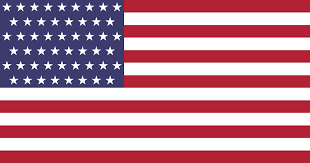
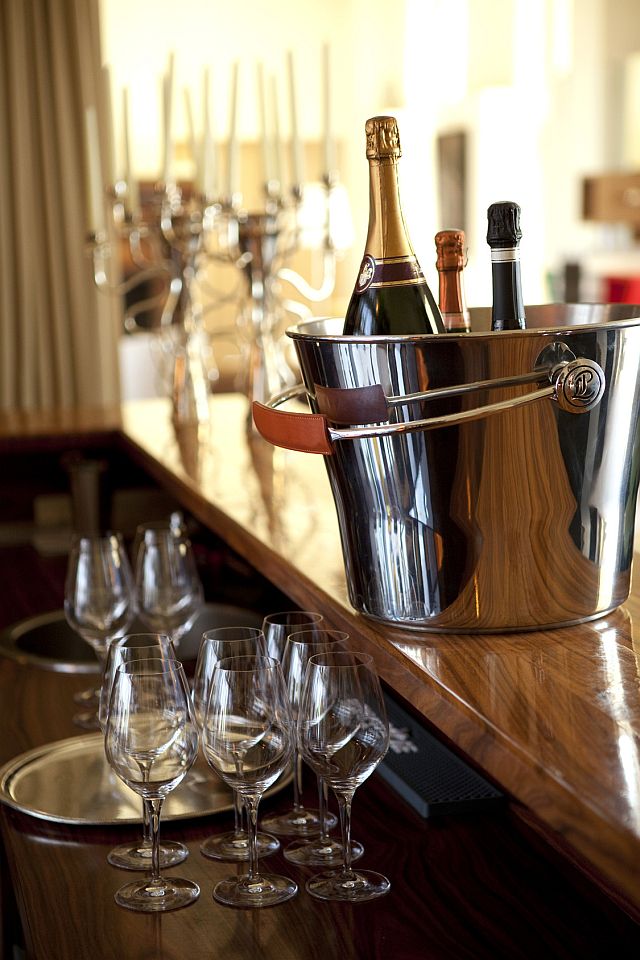 Over the past few weeks, several of the big champagne houses have been announcing their half-year results and it’s been good news all round. Not surprisingly, results across the board have shown big increases versus last year – not difficult when sales last year were so dreadful – and some houses have posted increases even versus 2019
Over the past few weeks, several of the big champagne houses have been announcing their half-year results and it’s been good news all round. Not surprisingly, results across the board have shown big increases versus last year – not difficult when sales last year were so dreadful – and some houses have posted increases even versus 2019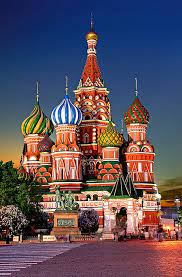 This month’s blockbuster story has come from Russia and has caused something of a sensation in Champagne.
This month’s blockbuster story has come from Russia and has caused something of a sensation in Champagne.